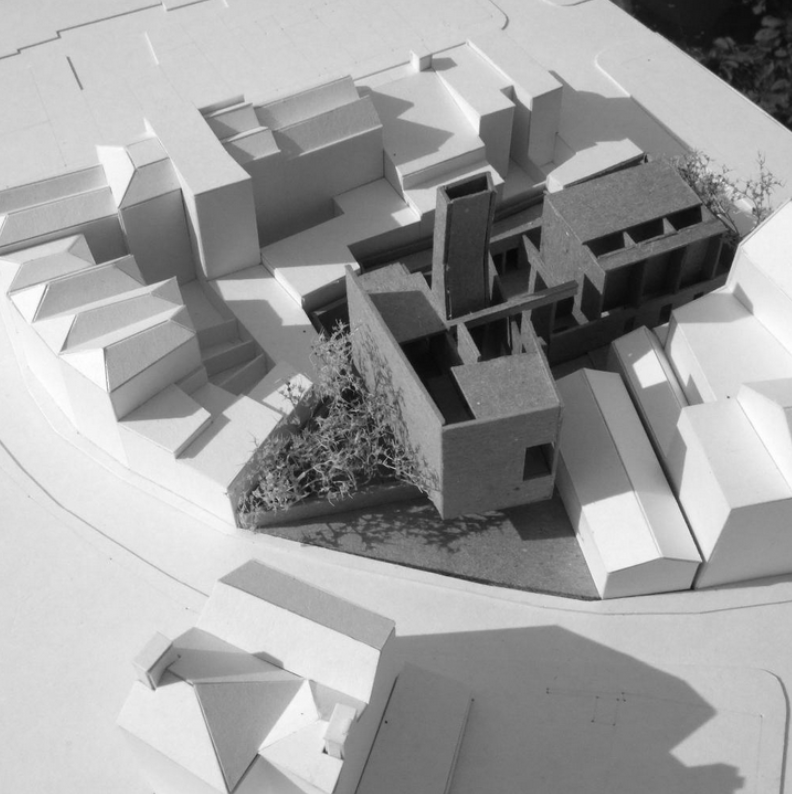This is achieved through a combination of
factors;
1. Clear page layout with an understandable hierarchy of
information.
Have a page format and stick to it; title, subtitle, margins,
grid. Your audience should know where to look/read to gain a general understanding
of what the page is about and where to look for further information. Variation
is exciting, it’s good to change from gridded photos to a large one of a model,
to a collage, to drawings etc… However the layout should not change to a point
of being distracting.
 |
| A gridded layout is a great format for showing a series of tests. Photos are taken from the same point allowing for a clear comparison between the controlled changes. |
2. Let the content shine, keep everything else simple.
Do
not overpower your work with overdesigned pages. No lines, no underlining, no
frames around images, no coloured boxes.
 |
| This page contains a wealth of analysis; plans, sections, photocopy, cut lines, all connected and needing little explanation. The content speaks for itself, the layout is kept clear and simple. |
3. Keep your font simple.
Use small letter sizes; 8pt, 9pt,
10pt. Use only 1 font throughout. Try sans serif ones like Ariel, Helvetica,
Gill Sans, Futura, Verdana, Andale. Or you could try Courier, Monaco, Times New
Roman, Georgia, Palatino.
 |
| A well labelled plan in which the text is kept simple and placed to the bottom left so as not to overpower the drawing. |
4. Have simple cover pages or chapter pages at the beginning
of every project.
These will help your audience to navigate the work. These could be white
or coloured sheets of paper with titles on them. Perhaps a few small images
hinting at what is to come…
5. Your portfolio should read like a book. It has a
narrative. It shows progression, process and thinking.
Like a book or essay, it
has a beginning, a middle and a conclusion. The first pages of a building
project usually introduce us to the site, the brief, the building programme and
the design ideas [introduction] this should be followed by the process;
sketches, models, drawings [body] and the final drawings, models and views
[conclusion].
 |
| Sketch layouts and sequences to help you plan page layout and narrative. |
6. When working on portfolio always keep your pages in order
and assess your portfolio by flicking through it from beginning to end and
reading it aloud.
Does it make sense? Are all key moments in the process
explained?
Is there something missing in the project story?
7. Every page is a thought: your pages should clearly
communicate only 1 thought or idea.
If you have pages that are not saying
anything important or clear redo them. If you have pages that are saying too
much consider turning them into 2 pages or editing them down. Always ask yourself: What is the message? How is this relevant? Is the page communicating it? Where needed improve...
8. Labels should tell us more than what we can already see.
If
a page has a collage on it, the label should not read ‘collage’ because we can see that it is a collage! Use your label to say something more; ‘the building embedded in the landscape’, 'collage exploring archiving at 5 scales', 'what is an inside out building?', etc...
 |
| Some images are so strong that they deserve to have a page to themselves, use your critical eye to ascertain when this is worthwhile and when a gridded collection of images is more suitable. |
9. Give it time. It takes a long time to make a good
portfolio.
Pages may need to be reworked if they are not communicating your
ideas. It is important to review and rework. Use portfolio tutorials to help
you to do this.
 |
| Don't be afraid to show thinking drawings |
 |
| Is the original drawing stronger than a scanned version? |
10. Finally avoid a portfolio that looks like a report.
A
portfolio should be exciting and full of passion, testing, experimenting.
Remember the people who look at your portfolio are looking at hundreds of them
in a day, how does yours stand out? Try varying the representation techniques, remember it is the content that should sing!
- If you have a lot of pages full of photos try to present
the same ideas in a different way – sketch or collage from the photos, trace photo montage - do
something else!
- If you have 5 precedent pages in a row full of some other architect's images ask yourself why? What is relevant about the precedent? Can you
draw this yourself? Can you adapt it, model it, make it your own?
- Make booklets, fold out pages, where possible use original
materials, sow, knit, pop-up, stick real materials,...
 |
| Can site photographs be better explained in a map? |
 |
| Rather than referencing another precedent can you draw that idea? |
 |
| Can a sequence of thoughts become a little booklet? Is the book bound? A concertina? A pop up?! |
For inspiration check out the following:
RIBA Presidents Medals Students Awards. A wonderful collection of nominated projects: http://www.presidentsmedals.com/default.aspx
AA Portfolios - Past Years:
http://www.aaschool.ac.uk/PORTFOLIO/PORTFOLIO/pastyears.php







































